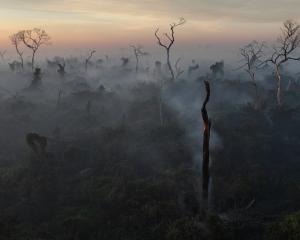Australia's heavy industries have joined forces to devise a $100 billion plan to go green amid global pressure to respond more rapidly to climate change.
An 88 percent cut to carbon emissions is possible across refineries, pipelines and steelworks from the Pilbara and Kwinana in the west to NSW's Hunter and Illawarra, and Gladstone in Queensland, according to research released on Monday.
Aiming to attract global capital and government support, the company-backed report focuses on urgently transforming the regions' five critical sectors that together account for one-eighth of Australia's total carbon emissions.
"This will require an unprecedented transformation of the energy system," chief executive of research organisation Climateworks Anna Skarbek said.
The scale of renewable energy and green hydrogen required would be equivalent to almost half of Australia's existing total electricity generation, and needs investment of up to $A100 billion.
Covered in the transition plan are iron and steel, aluminium, liquefied natural gas, chemicals such as fertilisers and explosives, and metals vital for global electrification including copper, nickel and lithium.
The overhaul would employ about 372,000 Australians, according to the report prepared by Climateworks and fellow research organisation Climate-KIC Australia.
Renewable energy zones would be positioned near industry and future hubs for green metals exports, consistent with efforts to limit global warming to 1.5 degrees.
But some of the technologies relied on in the report are not yet commercially viable, requiring more investment.
Australia Industry Group chief executive Innes Willox said industry pathways to net zero emissions are increasingly clear.
"While their costs and difficulties should not be underestimated, the current energy affordability crisis highlights the unsustainable cost of the status quo," he said.
AustralianSuper executive Andrew Gray said while net zero by 2050 commitments are important, companies need to have credible decarbonisation strategies in place to do it.
Christopher Davis, chief financial officer at explosives giant Orica, says the firm's presence in the Hunter Valley, Gladstone and the Pilbara means it understands the potential economic and environmental gains from regional decarbonisation.
"We must continue to work collectively to ensure our industry, and Australia, remains competitive in a low carbon economy," he said.
Kristian Fok, chief investment officer at super fund Cbus, said more collaboration across industry, government and financial institutions would reduce risk, increase employment and boost investment within Australia.
Industrial regions identified as critical to the plan include Portland and the Latrobe Valley in Victoria, Tasmania's Bell Bay, the Upper Spencer Gulf in South Australia, and Darwin.
"This report shows in detail how well placed Australian industry is to decarbonise," energy analyst Kobad Bhavnagri said.
"Australia has a clear opportunity to become one of the cleanest manufacturers in the world."
The Setting Up Industrial Regions For Net Zero report follows two years of work by the Australian Industry Energy Transitions Initiative, backed by philanthropy, business and the Australian Renewable Energy Agency.











